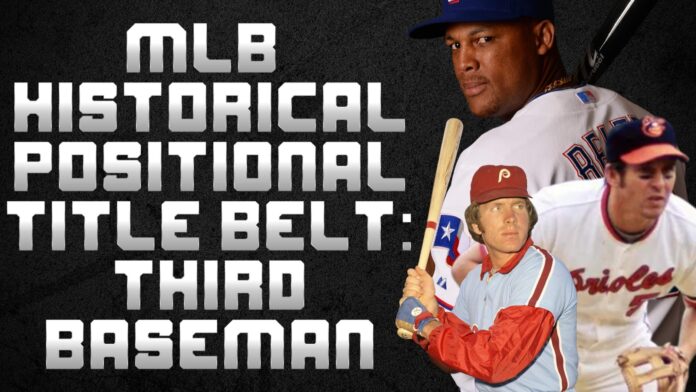Have you ever wondered who the best baseball player alive was in any given year? No? Well, I have. Check out the first article in this series for an explanation of the rules. Next up, Third Base. To the list!
Pre-Deadball 1871-1900
At the beginning of time or around 1871, baseball, more or less as we know it, became a professional sport. The first 29 years are known as “Pre-Deadball” because they preceded the next era, “Deadball” and came before the first World Series. It’s like Baseball’s B.C. A couple of players at the hot corner set the tone at the position at the beginning of baseball history.
Deacon White 1871-
James “Deacon” White was the first third baseman to stand out in league history. He split time at third and behind the plate but was primarily valued for his bat. Because of the demands of catching, White didn’t play 100 games in a season until his 14th season, yet he managed to play into his 40s and accumulate 2067 hits, 270 doubles, and an impressive .312/.346/.393 slash, a 121 wRC+. In 1877, he led the league in hits, triples, RBIs, slugging, and won his second batting title.
John McGraw 1891-
Know more for his fiery temper as a manager, and outsized influence on league structure and politics, John “Little Napoleon” McGraw was also a fantastic player. He was remarkably patient, drawing over 100 walks 3x in his career, and had back-to-back seasons with an OPB over .500. His playing career was relatively short but his managerial career was one of legend, finishing 2nd to Connie Mack in career victories and setting the career standard for ejections until Bobby Cox passed him a century later.
Deadball 1901-1919
The Deadball era was known for speed, bat-to-ball skills, terrible fields, horrible defense, and dominant pitching. A pair of greats dominated the era at the hot corner.
Jimmy Collins 1895-
Jimmy Collins took up the mantle and gained enormous value from his sure fielding. Only six 3B have accumulated more defensive runs above average than Jimmy and only Clete Boyer played fewer games of the group. He fell one hit shy of 2000 and smashed 352 doubles on the way to the HOF.
Frank Baker 1908-
Before fences and power-hitting were really a part of the game, hitting a home run was typically a result of speed and precision. In the Deadball era, very few players could subsist on power, but Frank “Home Run” Baker bucked the trend a bit. His numbers pale compared to today’s sluggers but he led the league in HRs four straight seasons and earned his nickname with a pair of dingers in the 1911 World Series. His 124.2 wcWAR+ stands as the standard for third basemen for 30 years and dwarfs the three baggers of the Liveball era.
Liveball 1920-1941
Ruth symbolized the transition from Deadball to Liveball as he began hitting baseballs over fences in great numbers. The twenty-one years that followed saw the sport grow in popularity before reaching a critical point in American history and pushing into the next era, Integration. Third base was a neglected position for most of the era but a few players stood out.
Heinie Groh 1923-
Heini Groh debuted back in 1912 and played 16 productive seasons across three franchises. He was an effective defender and at his peak had four straight seasons better than 130 wRC+. He won a pair of World Series rings and hit 308 doubles in his career.
Pie Traynor 1928-
Groh retired in ‘27 and Pie Traynor took the belt. Harold Joseph Traynor played 17 years, all for the Pittsburgh Pirates, and led them to the 1925 World Series. He was a consistently above-average player and as this list proves, was the best in baseball at 3rd for a few years, but is often considered one of the weakest resumes in the HOF.
Stan Hack 1932-
Taking the belt from Traynor, was Cubs standout Stan Hack. Hack was considerably more valuable than Traynor but is not yet in the Hall. Hack finished with a solid .301/.394/.397 slash, a 124 wRC+, and had a five-year peak from ‘38-42 worth 24.3 fWAR with a wRC+ of 131. Hack was only the third 3B to reach 100 wcWAR+.
Integration 1942-1960
Jackie Robinson, Larry Doby, Roy Campanella, Hank Aaron, Willie Mays, Satchel Paige and so many more burst into the major leagues as the color barrier fell. Their brilliance and impact were immense in their own right and furthered the disappointment that so many greats toiled in obscurity behind the veil, such as Josh Gibson, Bullet Rogan, and Oscar Charleston.
Bob Elliott 1948-
After Hack retired, and before one of the all-time greats debuted, the 1947 MVP Bob Elliott took the belt. Elliott was a steady offensive presence with 100+ RBIs 6x and a career wRC+ of 124. Only Pie Traynor and Lave Cross had more RBIs among 3B when he retired.
Eddie Mathews 1952-
One year before Elliott retired, Eddie Mathews debuted. An absolute superstar, Mathews exemplified steady excellence as the only player to play in Boston, Milwaukee, and Atlanta as a Brave. He mashed 40+ HRs 4x enroute to 512 which is 2nd all-time among primary 3Bs. From 1953-63 he had at least 5.4 fWAR every season and led all players in HRs, he was also 3rd in fWAR and offensive runs above average behind Mays & Mantle. He teamed up with Hammerin’ Hank to bring a title to the Braves in ‘57 and hung on for a second ring in Detroit in ‘68. His 191.8 wcWAR+ is second all-time among 3B.
Expansion 1961-1976
In 1961, the Los Angeles Angels and Washington Senators (Texas Rangers) joined the league. Then in ‘62 the New York Mets and Colt .45’s (Houston Astros) joined. Again in 1969 four more teams were added, the Kansas City Royals, Montreal Expos, San Diego Padres, and Seattle Pilots (Milwaukee Brewers). There have been three other expansion years but the sudden influx of major league roster spots in the 60s and 70s had competing effects of diluting the talent pool and giving more players opportunities to shine. A master gloveman dominated the era with some strong contenders for the belt.
Brooks Robinson 1969-
Third base saw a surge in the 60’s and 70’s with stars such as Ken Boyer, Ron Santo, Sal Bando, Darrell Evans, and Graig Nettles. They were all shutout from the belt because of the Human Vacuum, Brooks Robinson. Brooksie’s defense was the stuff of legend and he secured a positional record of 16 gold gloves to prove it. His bat was never quite at the same level but he put it all together in 1964 with 28 HRs, a .317/.368/.521 slash worth a 144 wRC+ and the MVP.
Free Agency 1977-1993
As the Mariners and Blue Jays were added signaling the end of the expansion era in ‘77, the reserve clause fell in ‘75, and a new Basic Agreement went into effect in ‘76, Players were now free to move around the league. Three titans at the position debuted in the 70’s including the greatest to ever stand at the hot corner.
Mike Schmidt 1972-
Michael Jack Schmidt debuted in ‘72 and took the belt from Brooksie. Schmidt was a monster as he secured three MVP awards, led the league in HRs 8x, won 10 gold gloves, and put up 74 Black Ink, 14th all-time. His ‘74, ‘77, and ‘80 seasons were 9+ in fWAR and placed in the top 15 all-time for third baseman. He had 548 HRs (1st among 3B), 1595 RBIs (4th among 3B), and a career 147 wRC+ (1st among NL/AL 3B). His dominance dwarfed other all-time greats such as George Brett, Paul Molitor, and the next belt holder.
Wild Card 1994-2011
After the disaster, which I blame on Bud Selig personally, of the ‘94 stoppage, the players and owners agreed to add more playoff teams, restructure the league, and it took the shape of the “modern” game. This era could also be called the Steroid Era but I went with Wild Card. A pair of 3B covered this era and almost the rest of league history up to now.
Wade Boggs 1990-
George Brett (176.2), Paul Molitor (141.9), and Buddy Bell (123.8) all had excellent careers. But it was Boggs (187.1) who got the belt after Michael Jack hung it up. As if a response to the immense power of Schmidt, Boggs was one of the league’s greatest finesse hitters. He secured 5 batting titles, launched 578 doubles, and led the league in OBP 6x including five years straight. He finished with 3010 hits, a .328/.415/.443 slash worth a 132 wRC+, and twice as many walks and strikeouts (1412/745).
Adrian Beltre 2000-
Boggs hung on all the way up to 1999 before handing the belt to Adrian Beltre, effectively shutting out Robin Ventura (105.4), Scott Rolen (144.7), and my personal favorite Chipper Jones (170.6). Beltre (181.9) was mostly defense at the beginning of his career before blossoming into a potent two-way star in his 30s. He did have a curious breakout in 2004 with the Dodgers when he launched 48 HRs, slashed .334/.388/.629 for a 161 wRC+, and put up 9.7 fWAR as the runner-up for the MVP. His career defensive runs above average trails only Brooks Robinson among 3B and his career 115 wRC+ makes him a rare double threat.
Expanded Playoffs 2012-Now
Coming up with a name for the current era was difficult. It hasn’t quite been long enough to truly evaluate the years since they added another playoff team. Rules have changed, teams have changed names and divisions, and the game has rapidly transformed into an extremely efficient display of athleticism and power. Beltre didn’t retire until 2018, so the belt has only been up for grabs the last few seasons.
Evan Longoria 2019-
The Tampa Bay Devil Rays came into existence in 1998 and aging stud Wade Boggs manned the hot corner for his last two seasons. After ten lean years, and a subtle name change, their first true superstar debuted. Evan Longoria burst onto the scene with the ‘08 Rookie of the Year award, and six straight seasons with a wRC+ over 130. He has since slowed down and appears to be nearing the end of the line. Interestingly, his wcWAR+ edge (114.8) over the current 3B studs Nolan Arenado (110.0) and Manny Machado (98.7) is not significant. If this article is updated next year or maybe two years from now, I’d venture it’ll be Nolan Arenado who will be the title belt holder for these seasons.
So there you have it, the third base title belt holders:
Deacon White 1871-1890
John McGraw 1891-1894
Jimmy Collins 1895-1907
Frank Baker 1908-1922
Heinie Groh 1923-1927
Pie Traynor 1928-1931
Stan Hack 1932-1947
Bob Elliott 1948-1951
Eddie Mathews 1952-1968
Brooks Robinson 1969-1971
Mike Schmidt 1972-1989
Wade Boggs 1990-1999
Adrian Beltre 2000-2018
Evan Longoria 2019-2023







